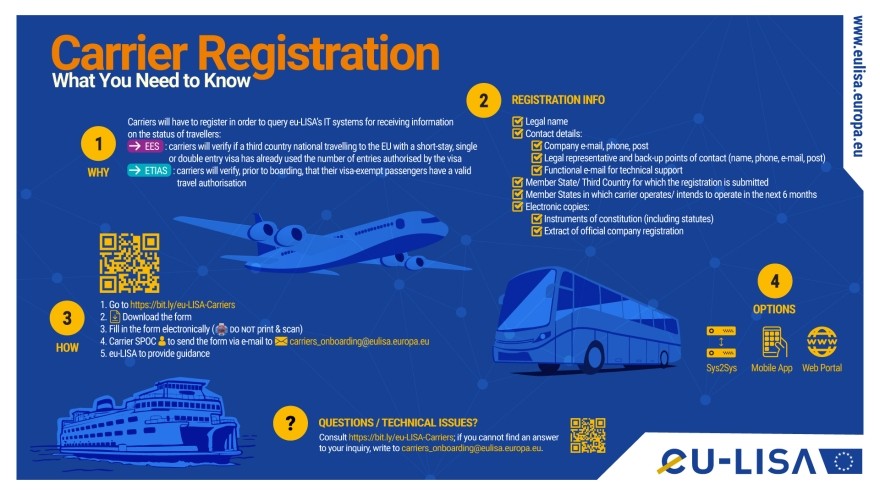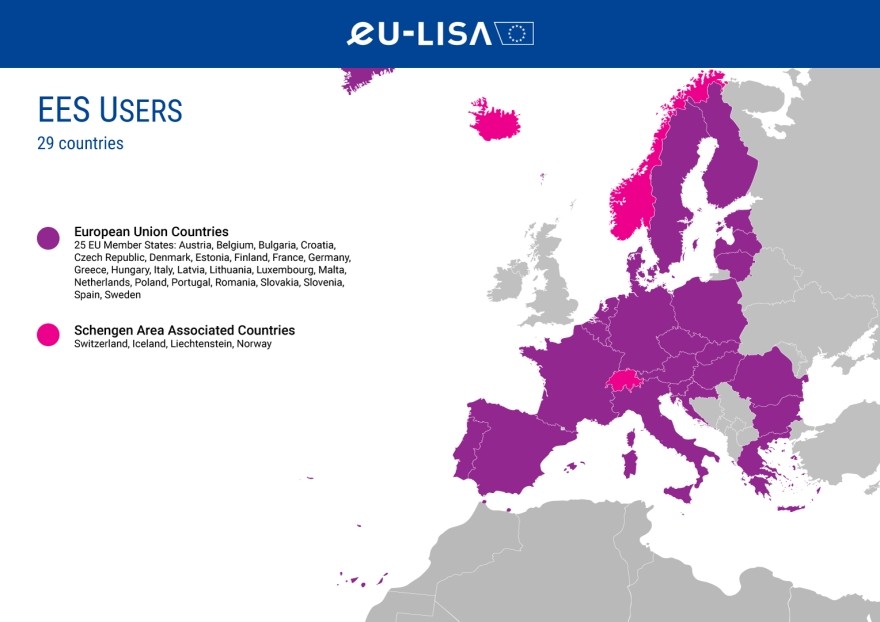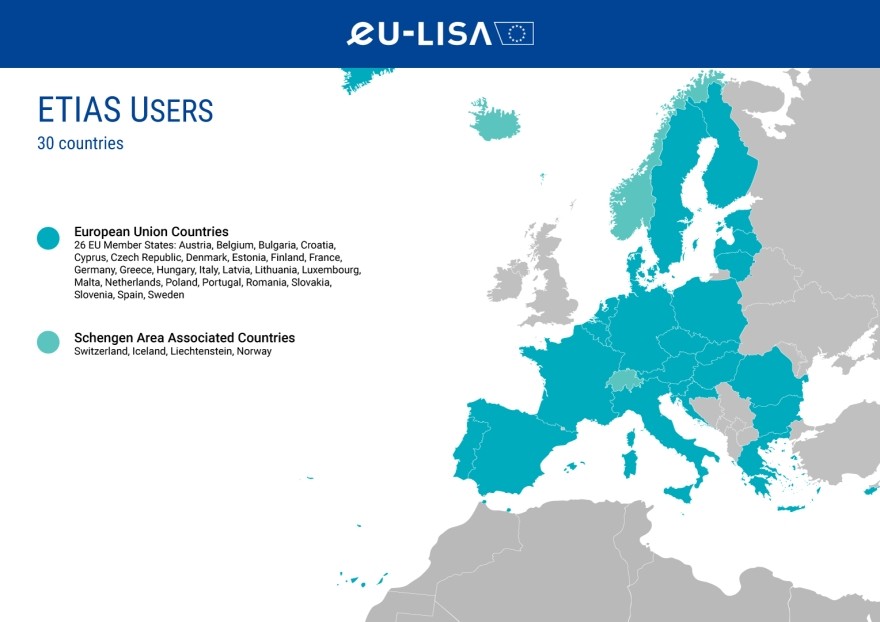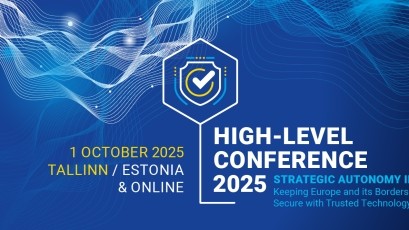Actions
EES Entered into Operation - Implications for Carriers

The new Entry/Exit System (EES) became operational on 12 October 2025. European countries using EES are introducing the system gradually at their external borders.
With the introduction of the EES, and to fulfil obligations under Article 26 of the Convention Implementing the Schengen Agreement, in addition to checking that a passenger has the required visa, carriers will need to:
- Register with eu-LISA;
- Use the carrier interface to verify whether non-EU nationals requiring visas have already used the number of entries authorised by their visa before boarding;
- Note: The use of the carrier interface is optional between 9 January 2026 and 9 April 2026, and it is mandatory as of 10 April 2026;
- Continue to verify the passport stamps until 6 October 2026.
Explanatory Materials
- Frequently Asked Questions (FAQ) in support of all carriers
- Carrier Implementation Process
- Carrier Interface Overview
- Carrier Interface Timeline and Registration
- Crew Exceptions
Overview
If you represent a carrier subject to the mentioned regulations, on this page you will find:
- step-by-step instructions,
- requirements,
- registration options (currently “System2System” is the available and preferred option),
- specific forms that can be downloaded in order to facilitate registration and future interactions.
Forms should be filled in electronically and sent by e-mail to carriers_onboarding [at] eulisa [dot] europa [dot] eu (carriers_onboarding[at]eulisa[dot]europa[dot]eu). After that, our team will contact you to provide additional guidance.
Further information can be found in the Introductory Letter and the Overview Infographic:
Carrier Registration
According to the European Commission's Implementing Regulations 2022/1380 and 2022/1409, carriers will have the legal obligation to query EES and ETIAS to receive answers regarding the status of travellers.
- EES, the Entry/Exit System, replaces the manual stamping of passports with an electronic record of entries and exits, and carriers will verify if a third-country national travelling to the EU with a short-stay, single or double entry visa has already used the number of entries authorised by their visa;
- For ETIAS, the European Travel Information and Authorisation System, carriers will have to verify, prior to boarding, that their visa-exempt passengers have a valid travel authorisation.
For further information or concerns linked to carrier registration, please contact our Carrier Onboarding and Support Team at carriers_onboarding [at] eulisa [dot] europa [dot] eu (carriers_onboarding[at]eulisa[dot]europa[dot]eu).
Downloadable Forms:
F01: Carrier Registration Form
F07: Carrier Security Convention
Working Group for Carriers
The Working Group for Carriers is an informal coordination body between eu-LISA, the European Commission, Frontex and carrier associations (for carriers operating at air and sea borders, and international carriers transporting groups overland by coach). Its main scope is to facilitate the preparation of carriers for the implementation of their obligations stemming from the legal framework of the EES and ETIAS Regulations and to ensure that carrier activities are aligned with the activities and planning of the EES and ETIAS Projects.
Read more: Working Group for Carriers
EES and ETIAS Key Principles
Why do carriers need to check travellers under the scope of EES (single and double entry visas)?
The manual stamping of passports will no longer exist after the full entry into operation of EES. However, carriers still need to check the validity of single and double entry visas, before departure, to avoid the refusal of concerned passengers at border control points.
The reply provided by the Carrier Interface for single and double entry visas will only check if the visa entry has been consumed or not; the Carrier Interface will not verify the authorised remaining days during the stay.
Why do carriers need to check travellers under the scope of ETIAS?
Carriers need to check the validity of the ETIAS Travel Authorisation before departure, to avoid entry refusal of concerned passengers at border control points because they are not in possession of a valid travel authorisation.
Part of the Smart Borders Programme, ETIAS aims to:
- Contribute to a higher level of security;
- Prevent illegal immigration;
- Contribute to the protection of public health;
- Enhance the effectiveness of border checks;
- Support the objectives of the Schengen Information System (SIS) and the Entry/Exit System (EES);
- Contribute to the prevention, detection and investigation of terrorist offences or other serious criminal offences.
Who are the main actors for EES?
- Non-EU nationals, visa-exempt, crossing the external borders of EU Member States;
- Border guards authorising or not a traveller to enter the territory of the EU;
- EU Member States immigration and law enforcement authorities;
- Air, sea and international carriers transporting groups overland by coach, which provide transport services to travellers.
Who are the main actors for ETIAS?
- Non-EU nationals, visa-exempt, crossing the external borders of EU Member States;
- Border guards authorising or not a traveller to enter the territory of the EU;
- EU Member States immigration and law enforcement authorities;
- Air, sea and international carriers transporting groups overland by coach, which provide transport services to travellers;
- ETIAS Central Unit (Frontex) and ETIAS National Units (designated authority for each EU Member State).
What are the EES and ETIAS obligations for carriers?
- Verify whether travellers who hold a short-stay visa issued for one or two entries have already used the number of entries authorised by their visa;
- Verify the status of the ETIAS application for travellers subject to the travel authorisation.
Where does EES apply?
The following European countries and institutions use EES:
25 EU Member States: Austria, Belgium, Bulgaria, Croatia, Czech Republic, Denmark, Estonia, Finland, France, Germany, Greece, Hungary, Italy, Latvia, Lithuania, Luxembourg, Malta, Netherlands, Poland, Portugal, Romania, Slovakia, Slovenia, Spain, and Sweden.
4 Schengen Associated Countries: Iceland, Lichtenstein, Norway, and Switzerland.
1 EU agency: Europol.
Where does ETIAS apply?
The following European countries and institutions use ETIAS:
26 EU Member States: Austria, Belgium, Bulgaria, Croatia, Cyprus, Czech Republic, Denmark, Estonia, Finland, France, Germany, Greece, Hungary, Italy, Latvia, Lithuania, Luxembourg, Malta, Netherlands, Poland, Portugal, Romania, Slovakia, Slovenia, Spain, and Sweden.
4 Schengen Associated Countries: Iceland, Lichtenstein, Norway, and Switzerland.
2 EU agencies: Europol and Frontex.





